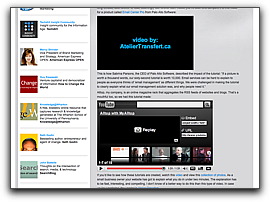Presentation models
This page highlights the presentations styles of masters and models Steve Jobs, Guy Kawasaki, Cliff Atkinson, the Takahashi Method, Lawrence Lessig, Common Craft, and Extreme Presentation. Many more presentation styles are worth exploration, including: Pecha Kucha, ignite talks, lightning presentations, and graphic facilitation,Steve Jobs
Example: 2007 Macworld keynote address
Article: How to Wow ‘Em Like Steve Jobs
- Sell the Benefit.
Steve Jobs does not sell bits of metal; he sells an experience. Instead of focusing on mind-numbing statistics, as most technologists tend to do, Jobs sells the benefit. For example, when introducing a 30 GB iPod, he clearly explains what it means to the consumer -- users can carry 7,500 songs, 25,000 photos, or up to 75 hours of video. In January when Jobs introduced the first Intel (INTC)-based Mac notebook he began by saying, "What does this mean?" - Practice, Practice, and Practice Some More
- Keep It Visual
- Exude Passion, Energy, and Enthusiasm
- "And One More Thing..."
At the end of each presentation Jobs adds to the drama by saying, "and one more thing." He then adds a new product, new feature, or sometimes introduces a band. He approaches each presentation as an event, a production with a strong opening, product demonstrations in the middle, a strong conclusion, and an encore -- that "one more thing!"
Guy Kawasaki

View the movies here.
Cliff Atkinson
This approach builds a structure for using a story-based presentation.
- "The first statement establishes the setting for the presentation so that everyone is on the same page. (Answers the questions: where are we, and when is it?)
- "The second statement establishes the protagonist, which in a live presentation should always be the audience. (Answers the question: who are we in this setting?)
- "The third statement establishes the imbalance, which in screenwriting terms is the inciting incident. This is the change that has occurred in the environment, otherwise called the problem, which spurs the protagonist into action. (Answers the question: why are we here?)
- "The fourth statement establishes the balance, or the place the audience wants to be rather than the imbalance they are in now. Another way of looking at this is that the imbalance in the previous statement is "Point A" and the balance in the current statement is "Point B". In this case, Point B is "successful innovation". (Answers the question: What do we want to see happen?)
- "The fifth statement establishes the solution, which is what you propose that the audience do or think differently at the end of the presentation. This is how you propose the audience will get from Point A to Point. (Answers the question: How do we get there from here?)"
Takahashi Method
The Takahasi Method is described in a blog entry at Presentation Zen, Living large: "Takahashi Method" uses king-sized text as a visual. There is an example in Japanese by Mr. Takahashi. If anyone were to have trouble making a presentation in this style, there's the Takahashi Method Generator.
Lawrence Lessig
Common Craft
A simple style that successfully presents complex technical topics in a palettable fashion for a wide audience. At Common Craft, "our product is explanation" and others have started to try to emulate this style. "Twitter in Plain English" embedded below is a good starting point and then you can browse the rest of the Common Craft collection.Extreme Presentation Method
For further reading
Two articles are available online for comparison and contrast.
Edward Tufte creates thoughtful books about visual design. For more on PowerPoint, see The Cognitive Style of PowerPoint by Edward Tufte. Graphics Press; 2nd edition. Tufte bibliography.
Donald Norman writes insightfully about user advocacy and human-centered design. Norman bibliography.
